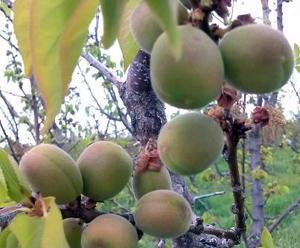This Week’s Fruit
Hass Avocados
Las Palmalitas, Carpinteria, CA
Creamy in texture, nutty in flavor, with a small to medium seed. The Hass skin is easy to peel and darkens from green to purplish-black as it ripens. You can tell it is ripe by the color of the skin (dark) and if it yields to pressure.
Pink Lady Apples & Fuji Apples
Cayuma Orchards, New Cayuma, CA
A cross between the Golden Delicious and Lady Williams, the Pink Lady is a crisp and juicy apple with a tart finish. A creamy white colored flesh that resists browning makes this an excellent apple for salads and slicing. Also a modern day favorite for eating out of hand. A cross between the Golden Delicious and Lady Williams, the Pink Lady is a crisp and juicy apple with a tart finish. A creamy white colored flesh that resists browning makes this an excellent apple for salads and slicing. Also a modern day favorite for eating out of hand. Fujis are a cross between Red Delicious and Ralls Janet, an heirloom apple dating back to Thomas Jeffrson. Fujis are loved by many for their crisp, sweet, and juicy character.
Hayward Kiwi
Chiechi Farms, Live Oak, CA
Originally known as the Chinese gooseberry due to its Chinese orgins. Hawyward Wright, a New Zealand nurseryman propagated his plants by grafting and they eventually became the preferred cultivar of growers due to their sweet flavor and thin skin.
Navel Oranges
Etheridge Farm, Dinuba, CA
California Navel Oranges are considered to be the best Navels for eating out of hand. They have a thick skin that is easy to peel, are seedless, and have a meaty and sweet flesh that makes them a perfect snack. Navels are also great for juicing and cooking.
Moro Blood Oranges
Frog Hollow Farm, Brentwood, CA
A beautiful orange to deep red flesh is revealed when you slice open a Tarocco. The flesh of the blood orange is firmer and more dense than an orange and its flavor is a little more tart. These beauties sweeten and darken in color as the season progresses.
A Note from Farmer Al
Dear CSA Members,
 Apricot abbondanza. What a glorious sight to see all those little baby “cots” lined up on both sides of every branch like soldiers marching in double file. But, it also means a lot of work to be done to reduce the crop load to a level which can be handled by the tree. This process is called thinning. It is the removal by hand of excess fruit, one by one, by workers up on ladders, using their thumbs and fore fingers to pinch off the fruit and drop it to the ground. The fruits are small (about the size of a nickel), green, and hard. My men are all highly skilled at this task and the fruits rain down like hail, clattering and chattering as they strike the metal steps of the ladders on their way to the ground. It really makes quite a racket but it is music to my ears as it is the harbinger of a big crop. It will be a good year for all. There is excitement in the air when thinning begins. The men are thrilled because it means more work, warmer days, and lots of camaraderie in the lush green orchards.
Apricot abbondanza. What a glorious sight to see all those little baby “cots” lined up on both sides of every branch like soldiers marching in double file. But, it also means a lot of work to be done to reduce the crop load to a level which can be handled by the tree. This process is called thinning. It is the removal by hand of excess fruit, one by one, by workers up on ladders, using their thumbs and fore fingers to pinch off the fruit and drop it to the ground. The fruits are small (about the size of a nickel), green, and hard. My men are all highly skilled at this task and the fruits rain down like hail, clattering and chattering as they strike the metal steps of the ladders on their way to the ground. It really makes quite a racket but it is music to my ears as it is the harbinger of a big crop. It will be a good year for all. There is excitement in the air when thinning begins. The men are thrilled because it means more work, warmer days, and lots of camaraderie in the lush green orchards.
While the “tree teams” are up on ladders thinning, the “ground teams” are on the ground, of course, weed whacking the tall grasses up and down each row of trees. This is in preparation for their next job, irrigation. What conventional farmers call weeds, we call our cover crop. It’s a diverse mixture of grasses, legumes, and broadleaf plants which this time of year are dense, tall, and lush. That’s why we need to mow them down all along the tree row….so that our micro sprinkles can disperse water to the entire root zone of each tree. So, as the weather warms up, so too, all of our crews become energized in preparation for the fruit, which we now can see in the trees.


 Follow
Follow
